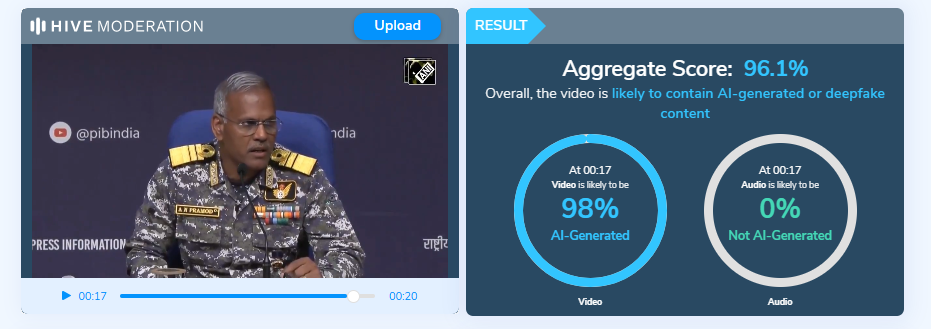#FactCheck - Viral Post of Gautam Adani’s Public Arrest Found to Be AI-Generated
Executive Summary:
A viral post on X (formerly twitter) shared with misleading captions about Gautam Adani being arrested in public for fraud, bribery and corruption. The charges accuse him, his nephew Sagar Adani and 6 others of his group allegedly defrauding American investors and orchestrating a bribery scheme to secure a multi-billion-dollar solar energy project awarded by the Indian government. Always verify claims before sharing posts/photos as this came out to be AI-generated.

Claim:
An image circulating of public arrest after a US court accused Gautam Adani and executives of bribery.
Fact Check:
There are multiple anomalies as we can see in the picture attached below, (highlighted in red circle) the police officer grabbing Adani’s arm has six fingers. Adani’s other hand is completely absent. The left eye of an officer (marked in blue) is inconsistent with the right. The faces of officers (marked in yellow and green circles) appear distorted, and another officer (shown in pink circle) appears to have a fully covered face. With all this evidence the picture is too distorted for an image to be clicked by a camera.


A thorough examination utilizing AI detection software concluded that the image was synthetically produced.
Conclusion:
A viral image circulating of the public arrest of Gautam Adani after a US court accused of bribery. After analysing the image, it is proved to be an AI-Generated image and there is no authentic information in any news articles. Such misinformation spreads fast and can confuse and harm public perception. Always verify the image by checking for visual inconsistency and using trusted sources to confirm authenticity.
- Claim: Gautam Adani arrested in public by law enforcement agencies
- Claimed On: Instagram and X (Formerly Known As Twitter)
- Fact Check: False and Misleading
Related Blogs

Introduction
Significantly, in March 2023, the Prevention of Money Laundering Act, 2002's regulations placed Virtual Digital Asset Service Providers functioning located under the purview of the Anti Money Laundering/Counter Financing of Terrorism (AML-CFT) scheme. An important step toward controlling VDA SP operations and guaranteeing adherence to Anti-Money Laundering and Combating the Financing of Terrorism (AML-CFT) regulations.
The significance of AML-CFT procedures
The AML-CFT framework's incorporation of Virtual Digital Asset Service Providers (VDA SPs) is essential for protecting the banking industry from illegal activities including the laundering of funds and counter-financing of terrorist attacks. These regulations become more crucial as the market for digital assets develops and becomes more well-known.
The practice of money laundering is hiding the source of the sum received illegally, thus it's critical to have strict policies in place to track down and stop these kinds of operations. Furthermore, funding for terrorism is a serious danger to international safety, hence stopping the flow of money to terrorist companies is a top concern for global officials.
The goal of policymakers' move to include VDA SPs in the AML-CFT architecture is to set up control and surveillance procedures that will guarantee these organisations' open and honest operations. This involves tracking transactions, flagging questionable activity, and conducting extensive customer investigations. Incorporating such procedures not only reduces the potential for financial crimes but also builds confidence and trust in the electronic asset market.
It is important to see the significance of AML-CFT procedures and the changes in the legal framework to reflect the evolving characteristics of digital currencies. These procedures are essential to preserving the reliability and safety of the wider banking system.
Notifications of Compliance Show Cause
Under Section 13 of the PMLA Act 2002, FIU IND sent adherence Show Cause Notices to nine offshore Virtual Digital Asset Service Providers (VDA SPs) as part of its dedication to upholding compliance with regulations. This affirmative step requires organisations to be scrutinised and attempted to bring them under inspection.
Governmental Response
The Director of FIU IND has addressed the Secretary of the Ministry of Electronics and Information Technology to take further measures due to the disregard of offshore firms. According to the notification, URLs connected to these organisations that operate in India in violation of the PML Act's requirements must be blocked.
Mandatory Registration for VDA SPs
Virtual Digital Asset Service Providers (both onshore and offshore) who perform a range of operations, including the trading of digital goods for monetary currencies, the distribution of digital currency, and the management or preservation of electronic assets, are now obliged to register with FIU.
Range of Statutory Responsibilities
In accordance with the PML Act, VDA SPs are subject to several requirements, including documentation, disclosure, and other duties. One of their responsibilities is to register with the FIU IND. The primary focus is on guaranteeing that VDA SPs comply with AML-CFT protocols, hence enhancing the general reliability of the banking industry.
Difficulties with Offshore Compliance
There are many obstacles in guaranteeing that offshore organisations comply with Anti Money Laundering/Counter Financing of Terrorism (AML-CFT), chief amongst them being their unwillingness to undergo registration. Some overseas Virtual Digital Asset Service Providers (VDA SPs) have been reluctant to comply with the existing rules and regulations, even though they cater to a significant number of Indian users. There are several reasons for this hesitation, such as worries about heightened monitoring, the expense of compliance, and the apparent complexity of governmental processes. Regulatory organisations have taken steps to close the discrepancy between offshore businesses' real activities and the regulations they must follow. In addition to maintaining the trustworthiness of the economic system, resolving the issues with offshore adherence is essential for promoting confidence and openness in the market for electronic assets.
Conclusion
FIU IND has demonstrated its dedication to creating an effective regulatory framework for Virtual Digital Asset Service Providers through its recent measures. India hopes to fortify its countermeasures against money laundering and safeguard the financial well-being of its users by expanding the AML-CFT legislation to offshore firms. The continuous efforts to restrict the URLs of non-compliant companies show a proactive approach to stopping illicit activity and fostering a safe and law-abiding virtual asset ecosystem. The safety and soundness of the banking sector will be crucially maintained by laws and regulations as the digital world develops.
References
- https://pib.gov.in/PressReleasePage.aspx?PRID=1991372
- https://www.thehindubusinessline.com/books/reviews/business-economy/fiu-ind-issues-compliance-showcause-notices-to-nine-offshore-vda-sps/article67684613.ece
- https://business.outlookindia.com/news/fiu-issues-notice-to-9-offshore-crypto-platforms-writes-to-meity-for-blocking-of-urls

Introduction
Iran stands as a nation poised at the threshold of a transformative era. The Islamic Republic, a land of ancient civilisations now grappling with the exigencies of the 21st century, is now making strides in the emerging field of artificial intelligence (AI). This is not merely an adoption of new tools; it is a strategic embrace, a calculated leap into the digital unknown, where the potential for economic growth and security enhancement resonates with the promise of a redefined future.
Embarking on this technological odyssey, Iranian President Ebrahim Raisi, in a conclave with the nation’s virtual business activists, delineated the ‘big steps’ being undertaken in the realm of AI. The gathering, as reported by the pro-government Tasnim News, was not a simple exchange of polite remarks but a profound discourse that offered an incisive overview of the burgeoning digital economy and the strides Iran is making in the AI landscape. The conversation deeply revolved around the current ecosystem of technology and innovation within Iran, delving into the burgeoning startup culture and the commendable drive within its youth populace to propel the nation to the forefront of technology.
Iranian AI Integration
Military Implications
The discourse ranged from the current technological infrastructure to the broader implications for the security and defense of the region. The Iranian polity, with its rich history that seamlessly blends with aspirations for the future, is acutely aware that the implications of AI reach far beyond mere economic growth. They extend into the very fibres of military might and the structure of national security. The investment in cyber capabilities in Iran is well-documented, a display of shrewdness and pragmatism. And the integration of AI technologies is the next logical step in an ever-evolving defense architecture. Brigadier General Alireza Sabahifard, Commander of the Iranian Army Air Defense Force, has underscored the pivotal role of AI in modern warfare. He identifies the ongoing adoption of AI technologies as a strategic imperative, a top priority fundamentally designed to elevate the air defense capabilities in Iran to meet 21st-century threats.
Economic Implications
Yet, the Iranian pursuit of AI is not solely confined to bolstering military prowess. It is also pervasive in nurturing economic opportunity. President Raisi’s rhetoric touches upon economic rejuvenation, job creation, and the proliferation of financial and legal support mechanisms, all blurred into a cohesive vision that would foster a suitable environment for the private sector in the AI domain. The ambition is grand and strikingly clear — a nation committed to training several thousand individuals in the digital economy sector, signaling a deep-rooted commitment to cultivating a healthy environment for AI-driven innovation.
The Iranian leader’s vision extends beyond the simple creation of infrastructure. It extends to the fostering of a healthy, competitive, and peaceful social milieu where domestic and international markets are within easy reach, promoting the prosperity of the digital economy and its activists. Such a vision of technological symbiosis, in many Western democracies, would be labelled as audaciously progressive. In Iran, however, withdrawing a major chunk of economic investments from the country's security state adds layers of complexity and nuance to this transformative narrative.
Cultural Integration
Still, Iran’s ambitious AI journey unfolds with a recognition of its cultural underpinnings and societal structure. The Nexus between the private sector, with its cyber-technocratic visionaries, and the regime, with its omnipresent ties to the Islamic Revolutionary Guard Corps, is a tightrope that requires unparalleled poise and vigilance.
Moreover, in the holy city of Qom, a hub of intellectual fervour and the domicile of half of Iran's 200,000 Shia clerics, there burgeons a captivating interest in the possible synergies between AI and theological study. The clerical establishment, hidden within a stronghold of religious scholarship, perceives AI not as a problem but as a potential solution, a harbinger of progress that could ally with tradition. It sees in AI the potential of parsing Islamic texts with newfound precision, thereby allowing religious rulings, or fatwas, to resonate with the everchanging Iranian society. This integration of technology is a testament to the dynamic interplay between tradition and modernity.
Yet the integration of AI into the venerable traditions of societies such as Iran's is threaded with challenges. Herein lays the paradox, for as AI is poised to potentially bolster religious study, the threat of cultural dissolution remains present. AI, if not judiciously designed with local values and ethics in mind, could inadvertently propagate an ideology at odds with local customs, beliefs, and the cornerstone principles of a society.
Natural Resources
Similarly, Iran's strategic foray into AI extends into its sovereign dominion—the charge of its natural resources. As Mehr News Agency reports, the National Iranian Oil Company (NIOC) is on the cusp of pioneering a joint venture with international tech juggernauts, chiefly Chinese companies, to inject the lifeblood of AI into the heart of its oil and gas production processes. This grand undertaking is nothing short of a digital renaissance aimed at achieving 'great reforms’ and driving a drastic 20% improvement in efficiency. AI’s algorithmic potency, unleashed in the hydrocarbon fields, promises to streamline expenses, enhance efficacy, and maximise production outputs, thereby bolstering Iran's economic bulwark.
The AI way Forward
As we delve further into Iran's sophisticated AI strategy, we observe an approach that is both vibrant and multi-dimensional. From military development to religious tutelage, from the diligent charge of the environment to the pursuit of sustainable economic development, Iran's AI ventures are emblematic of the broader global discourse. They mark a vivid intersection of AI governance, security, and the future of technological enterprise, highlighting the evolution of technological adoption and its societal, ethical, and geopolitical repercussions.
Conclusion
The multifaceted nature of Iran's AI pursuits encapsulates a spectrum of strategic imperatives, bringing the spearheads of defense modernisation and religious academics with the imperatives of resource allocation. It reflects a nuanced approach to the adoption and integration of technology, adjudicating between the venerable pillars of traditional values and the inexorable forces of modernisation. As Iran continues to delineate and traverse its path through the burgeoning landscape of AI, attending global stakeholders, watch with renewed interest and measured apprehension. Mindful of the intricate geopolitical implications and the transformative potential inherent in Iran's burgeoning AI endeavours, the global community watches, waits, and wonders at what may emerge from this ancient civilisation’s bold, resolute strides into the future.
References
- https://www.jpost.com/middle-east/article-792391
- https://www.ft.com/content/9c1c3fd3-4aea-40ab-977b-24fe5527300c
- https://www.foxnews.com/world/iran-looks-ai-weather-western-sanctions-help-military-fight-cheap

Executive Summary:
A viral video (archived link) circulating on social media claims that Vice Admiral AN Pramod stated India would seek assistance from the United States and President Trump if Pakistan launched an attack, portraying India as dependent rather than self-reliant. Research traced the extended footage to the Press Information Bureau’s official YouTube channel, published on 11 May 2025. In the authentic video, the Vice Admiral makes no such remark and instead concludes his statement with, “That’s all.” Further analysis using the AI Detection tool confirmed that the viral clip was digitally manipulated with AI-generated audio, misrepresenting his actual words.
Claim:
In the viral video an X user posted with the caption
”India sells itself as a regional superpower, but its Navy Chief’s own words betray that image. If Pakistan attacks, their plan is to involve Trump, not fight back. This isn’t strategic partnership; it’s dependency in uniform”.
In the video the Vice Admiral was heard saying
“We have worked out among three services, this time if Pakistan dares take any action, and Pakistan knows it, what we are going to do. We will complain against Pakistan to the United States of America and President Trump, like we did earlier in Operation Sindoor.”

Fact Check:
Upon conducting a reverse image search on key frames from the video, we located the full version of the video on the official YouTube channel of the Press Information Bureau (PIB), published on 11 May 2025. In this video, at the 59:57-minute mark, the Vice Admiral can be heard saying:
“This time if Pakistan dares take any action, and Pakistan knows it, what we are going to do. That’s all.”

Further analysis was conducted using the Hive Moderation tool to examine the authenticity of the circulating clip. The results indicated that the video had been artificially generated, with clear signs of AI manipulation. This suggests that the content was not genuine but rather created with the intent to mislead viewers and spread misinformation.

Conclusion:
The viral video attributing remarks to Vice Admiral AN Pramod about India seeking U.S. and President Trump’s intervention against Pakistan is misleading. The extended speech, available on the Press Information Bureau’s official YouTube channel, contained no such statement. Instead of the alleged claim, the Vice Admiral concluded his comments by saying, “That’s all.” AI analysis using Hive Moderation further indicated that the viral clip had been artificially manipulated, with fabricated audio inserted to misrepresent his words. These findings confirm that the video is altered and does not reflect the Vice Admiral’s actual remarks.
Claim: Fake Viral Video Claiming Vice Admiral AN Pramod saying that next time if Pakistan Attack we will complain to US and Prez Trump.
Claimed On: Social Media
Fact Check: False and Misleading


